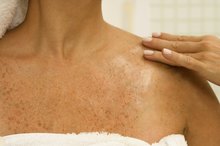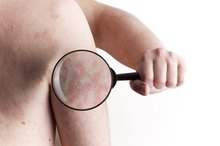Can You Restore the Pigment to White Spots on the Skin?
Perfectly even skin tone is hard to achieve. Your skin color, or pigment, is produced by cells called melanocytes. These cells can become damaged in many ways, including too much sun exposure, and leave you with a mottled complexion or white spots on your skin. White spots are caused by a lack of pigmentation and can signal conditions such as eczema, a yeast infection or vitiligo. Methods for restoring the pigment to your skin vary with the severity of your condition.
Visit a dermatologist if you notice white spots on your skin that do not go away on their own. According to the Mayo Clinic, these areas of depigmentation can stem from easily resolved situations such as eczema or a fungal infection. Vitiligo and psoriasis are more challenging skin diseases that can cause you to lose pigment. They can be treated but not cured.
How to Restore the Pigment to White Spots on the Skin
Learn More
Apply a moisturizing lotion to the dry, itchy white spots on your skin if you have been diagnosed with eczema, also known as dermatitis. Try not to use products with heavy scents or those that are abrasive in nature. The Mayo Clinic explains that white spots caused by dermatitis can be eliminated through the careful use of hypoallergenic toiletries 3. You can find nonprescription, unscented lotions at drugstores or mass merchandisers.
Apply antifungal creams if a yeast infection has caused your skin to form unusual areas of pigmentation. Infections of this type called are called tinea versicolor and are treated with topical medications by prescription, as directed by your doctor.
Hyperpigmentation While on Birth Control
Learn More
Apply prescription-strength steroidal medications to skin affected by vitiligo. The American Osteopathic College of Dermatology explains that steroids are the first-line treatment for vitiligo and are usually used for months at a time to help new pigment cells form in the skin 2. Your doctor will monitor you carefully to determine whether your condition is improving or worsening—using too much of a steroid medication may cause more damage to your skin.
Take a medication called psoralen to help restore normal coloring to your skin. Psoralen is available by prescription only and may be used either orally or topically, several times a week. The medication is for people who have vitiligo on more than 20 percent of their bodies. Psoralen is used in conjunction with light therapy.
Ask your doctor about a type of light therapy called "psoralen plus ultraviolet A" (PUVA). If you are taking an oral form of the drug, you'll take it two hours before being exposed to the ultraviolet rays. If the medication is applied to your skin, you'll have light therapy within a half hour of the application. PUVA treatments are scheduled two or times a week until a normal pigment is achieved, according to the Mayo Clinic 1.
Consider surgical means to restore pigment if you have a severe case of white spots due to vitiligo. Skin grafts and blister grafting are two procedures in which normal skin is transferred to the spots that lack color.
Warnings
Surgical restoration of skin color may produce scarring and carries a risk of infection.
Related Articles
References
- Mayo Clinic: Vitiligo Treatments and Drugs
- American Osteopathic College of Dermatology: Vitiligo
- Mayo Clinic: White Patches on Skin
- Grimes PE. (2017). Vitiligo: Pathogenesis, clinical features, and diagnosis. Tsao H, ed. UpToDate.
- Grimes PE. (2017). Vitiligo: Pathogenesis, clinical features, and diagnosis. Tsao H, ed.
- Baldini E, Odorisio T, Sorrenti S, et al. Vitiligo and Autoimmune Thyroid Disorders. Front Endocrinol (Lausanne). 2017;8:290. doi:10.3389/fendo.2017.00290
- Dermatologist offers unique treatment for vitiligo skin discoloration. UT Southwestern Medical Center. July 16, 2015.
- Genetics & Incidence. Vitiligo Support International.
- Vitiligo: Diagnosis and treatment. American Academy of Dermatology.
- Liu LY, Strassner JP, Refat MA, Harris JE, King BA. Repigmentation in vitiligo using the Janus kinase inhibitor tofacitinib may require concomitant light exposure. J Am Acad Dermatol. 2017 Oct;77(4):675-82. doi: 10.1016/j.jaad.2017.05.043
- Vrijman C et al. The prevalence of thyroid disease in patients with vitiligo: a systematic review. Br J Dermatol 2012 Dec;167(6):1224-35. doi: 10.1111/j.1365-2133.2012.11198.x
Writer Bio
Erica Roth has been a writer since 2007. She is a member of the Society of Professional Journalists and was a college reference librarian for eight years. Roth earned a Bachelor of Arts in French literature from Brandeis University and Master of Library Science from Simmons College Graduate School of Library and Information Science. Her articles appear on various websites.








